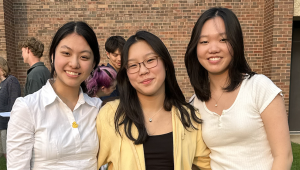Low income students among the 1%
Although 4% is a relatively small figure, considering our school has over 4,000 students, this means that over 160 kids… are provided with financial assistance
September 23, 2016
Given the socio-economic connotation of our school, it is often easy to reduce New Trier to being a school where money, or lack thereof, is never among any of our top concerns.
With that in mind, what is swept under the rug is that in this community full of trust funds and successful entrepreneurs, there still rests a portion of students who need financial assistance.
According to New Trier’s 2014-2015 Illinois Report Card, roughly four percent of the student body consists of low-income students.
According to the report card, “students meet the low-income criteria if they receive or live in households that receive public aid from SNAP (Supplemental Nutrition Assistance Program) or TANF (Targeted Assistance for Needy Families); are classified as homeless, migrant, runaway, Head Start, or foster children; or live in a household where the household income meets (USDA) guidelines to receive free or reduced-price meals.”
Although 4% is a relatively small figure, considering our school has over 4,000 students, this means that over 160 kids you see walking in the halls are provided with financial assistance.
Athena Arvanitis, the Director of Student Life, leads the department that helps these students receive the aid they need.
In terms of how to qualify for financial assistance, Arvanitis said, “The federal government puts forth income guidelines. You qualify for assistance based on your household income and your family size.”
For a family to receive aid, Arvanitis said, “The parents decide whether or not to apply or go through the process to receive financial assistance.”
The four main types of assistance available are the free lunch program, fee waivers, textbook loan program, and transportation to school.
Assistance for the iPad loan program is also offered. Arvanitis said, “That’s kind of an add-on, because in our community, we have the ability to offer more help.”
“We want every student in our school to have access to our educational and extracurricular programs during their four years. We don’t want finances to limit someone’s participation. So what we do is work with families to assure that students have access to all of these things that other students have,” Arvanitis said.
Although the school does an excellent job helping students succeed, the challenge for such students often rests in fitting in with a community that rarely ever worries about the amount in their bank accounts.
Jaine Archambeau, a junior who receives financial assistance, said, “It definitely feels like I’m left out. I mean I am better with it now, and the quality of the school definitely outweighs the fact I’m an outlier, but in middle school and early high school I would get self-conscious about not being able to do the same things as other students.”
This seems to be an opinion echoed by many recipients of freshman aid. In a community where common topics of conversation include which tropical island to visit for senior spring break or what college has the best campus, regardless of financial aid offered, worrying about whether or not the cost of a certain textbook is too high is out of the ordinary.
As one student who wishes to remain anonymous said, “One of the hardest parts of going here is that although I’m associated with all of the negative connotations of the bubble, I can’t be a part of what it has to offer, or at least all of the lavish things that everyone believes it entails.”











































